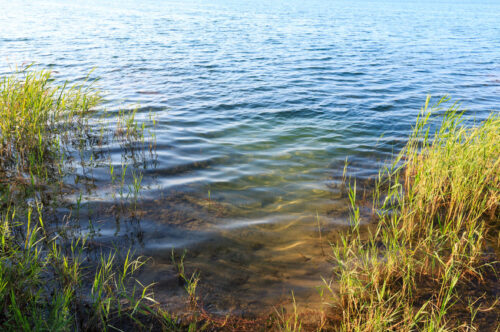Algae contributing to decline in Great Lakes fish population

Shallow Lake Erie must stick to its strict diet to starve its problematic algal blooms, but the four deeper Great Lakes face a tricky dilemma balancing their nutrient needs, according to a new report by the International Joint Commission’s (IJC) Great Lakes Science Advisory Board. Understanding Declining Productivity in the Offshore Regions of the Great Lakes looks at the decline in fish populations in the offshore regions of Lakes Huron, Michigan, Ontario and Superior. In the report, the Science Advisory Board (SAB) recommends a cooperative approach to ecosystem forecasting science.
Many complex factors contribute to the observed decline in fish populations in four of the five Great Lakes. Ultimately, however, disruptions to the food web and nutrient cycle are a cause of declining offshore productivity of the fishery in every Great Lake except Erie.
The offshore nutrient phosphorus levels in every lake except Erie are below the bi-national targets established under the Great Lakes Water Quality Agreement.
“Reaching these nutrient targets is one of the Great Lakes research and management community’s most outstanding successes in the last 50 years,” said Pierre Béland, IJC Canadian co-chair. “However, the lakes need a balanced diet of nutrients, and nutrients are an important part of the food web in the deeper offshore zones of the lakes. Below-target nutrient loads are one part of this problem.”
Despite below-target nutrient loads, harmful and nuisance algae persist. From soupy, toxic blue-green algae (cyanobacteria) floating out near drinking water intakes, to stringy Cladophora algae creating a stinky mess on beaches, the algae are feasting on nutrients that are “trapped” there by invasive zebra and quagga mussels. These invasive species and other physical and biological changes disrupt the food web and the lakes’ normal nutrient cycle from the nearshore to the offshore.
For every Great Lake except Lake Erie, there is an observed decrease in the fish populations caught in offshore waters.
“The puzzle is that, at the same time as we see algae in the nearshore, we see fewer, leaner top predator fish like Lake Trout growing out in the deeper parts of the lakes. It is a proverbial famine for those fish because there are not enough nutrients cycling to the offshore to support their food supply,” said Rob Sisson, IJC US Commissioner. “Invasive species are therefore another important part of this complex problem that needs to be addressed.”
The Science Advisory Board developed this report with significant involvement and partnership from both water quality and fisheries science and management organizations, including the Great Lakes Fishery Commission (GLFC) based in Ann Arbor, Michigan. The report recommends greater coordination between nutrients and fisheries management fields through an ecosystem-based approach.
“The findings and recommendation of this Science Advisory Board report are an unambiguous call to action for Canadian and US government leadership to explore and implement a holistic, ecosystem-based approach to managing invasive species, nutrients and fisheries, not just one or the other in isolation,” said Jeff Ridal, SAB Science Priority Committee Canadian co-chair and executive director of the River Institute at Cornwall, Ontario.
“One important outcome is that the collaboration that went into creating this report has inspired more coordination, particularly in developing better integrated hindcasting and forecasting modeling tools that link the nearshore and the offshore,” said Carol Miller, SAB Science Priority Committee US co-chair and director of Healthy Urban Waters at Wayne State University in Detroit, Michigan.
“Fishery managers in Canada and the United States are acutely aware that Great Lakes food webs have been compromised by the establishment of invasive species, particularly dresseinid mussels,” said Bob Lambe, executive secretary of the binational GLFC. “They will be interested in the findings from this report and the potential for developing new forecasting approaches to inform collaborative environmental management that addresses nutrients, invasive species and fish production in the Great Lakes.”
“The ecosystem models we currently work with are optimized for nutrients or fisheries, for nearshore or offshore, for large or small scales. We need to collaborate on tools that can help us see the ecosystem-level picture,” said Joe DePinto, SAB Science Priority Committee member, report co-author and independent consultant. “Efforts to model, monitor and manage the lakes should consider the nearshore and offshore zones together, and focus on the exchange of nutrients and biota between the two zones.”
“Coordination in developing forecasting models and tools is a priority for ecosystem-based management of the lakes if we are to truly succeed at adaptive management,” said Robert Hecky, SAB Science Priority Committee member, report co-author and professor emeritus at the University of Minnesota-Duluth Large Lakes Observatory.
“Therefore, leadership is important to regularly convene scientists and work on clarifying the relationship between excess algal growth in the nearshore and declines in nutrients and offshore fish populations,” said Hecky.
The IJC transmitted this report to the governments of Canada and the United States and to the co-chairs of the Great Lakes Executive Committee. The Great Lakes Executive Committee is the binational body that coordinates government activities under the Canada-US Great Lakes Water Quality Agreement.
The IJC Science Advisory Board Science Priority Committee and the GLFC will continue to work together to present and discuss this report with GLFC Committees, Great Lakes Water Quality Agreement Committees for Annex 2 (Lakewide Action and Management Plans) and Annex 4 (Nutrients), and other audiences. The IJC has drawn governments attention to the important work done by the Great Lakes Commission and the Invasive Mussel Collaborative and encourages the Great Lakes Executive Committee to explore how they might support addressing the issue.
Provided information



